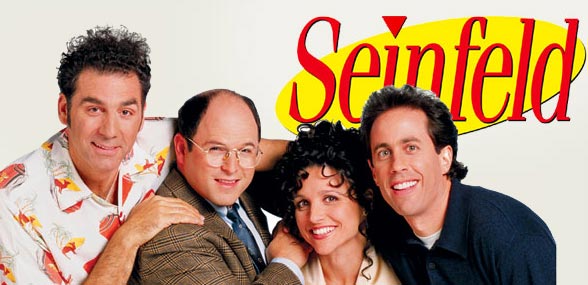When I learned that #SeinfeldTaughtMe is a trending theme on Twitter, I had to jump into the conversation.
This is what #SeinfeldTaughtMe about Judaism.
With “Seinfeld,” ambivalence about Jewishness became a prime time phenomenon.
In 1989, the late Brandon Tartikoff sat down with two fellow NBC executives. They were watching a pilot for a new sitcom, which was then called “The Seinfeld Chronicles.”
What was Tartikoff’s assessment of the future “Seinfeld?”
“Too Jewish.”
Here’s the thing about that phrase: “too Jewish.”
There is probably no record of any gentile ever saying it.
“Too Jewish” is a charge that Jews tend to level at themselves.
So, the history of “Seinfeld” is a chapter in American Jewish identity.
Jewish identity can be ambiguous.
Jerry Seinfeld is Jewish. He has visited Israel on several occasions, and he supports Israel. His character, Jerry Seinfeld, is also, of course, Jewish.
As are his parents; what, please, can be more Jewish than living at the Del Boca Vista?
Jason Alexander is Jewish, and is also committed to Israel and Jewish causes.
As for his character, George Costanza — well, more on that later.
Jerry Stiller and Estelle Harris, who play George’s parents, are both Jewish.
But, are the Costanzas Jewish?
The Costanzas, despite their Italian surname, “seem Jewish” (whatever that means). Perhaps, they are, as Jason Alexander once intimated, Jews who wound up in a federal witness protection program.
Michael Richards, is apparently not Jewish. Neither is his character, Kramer.
But, then, there’s Julia Louis-Dreyfus, who played Elaine.
Elaine is decidedly not Jewish; she is described as having shiksappeal.
But, Julia-Louis Dreyfus is, after all, a Dreyfus. She is somehow related to Alfred Dreyfus, whose trial on trumped up treason charges was a catalyst for the founding of political Zionism.
The Dreyfus family tree goes back to RASHI, the great medieval commentator, and even further back, to King David himself.
No doubt about it: The Dreyfus family is Jewish royalty — almost, but not quite, Rothschilds.
But, alas: Julia L-D does not identity as being Jewish.
Julia Louis-Dreyfus is one of America’s funniest comediennes. She is also one of many Americans who have a connection to a glorious Jewish past — with, as yet, no connection to a glorious Jewish future.
Making out during “Schindler’s List” is not a great move.
Recall the episode, in which the despicable mailman, Newman (also, it would appear, not Jewish) spotted Jerry and his kashrut-observant girlfriend, Rachel, making out during a showing of “Schindler’s List.”
Newman then ratted Jerry and Rachel out to Jerry’s parents, who, of course, were appalled.
Why were they so upset — especially after they had insisted that Jerry go see “Schindler’s List?” — “You must!”
Here we learn about the phenomenon of the holy.
The definition of holiness is that certain things are appropriate in that context, and certain things are inappropriate.
- Holy time, such as Shabbat. Attending services, cool. Shopping (from a traditional Jewish point of view), not cool.
- Holy places — say, a synagogue. Entering serenely — sure. Riding in on a skateboard? Not good.
The experience of watching “Schindler’s List” became, suddenly, a holy Jewish experience — a mitzvah, as it were.
To make out during “Schindler’s List” is no more appropriate than, well, munching on a bacon cheeseburger at Yom Kippur services.
Remember the recent controversy over people shooting selfies in Auschwitz?
But, of course, a cinematic representation of a particular aspect of the Shoah is hardly the same as the historical experience itself – which I suspect is precisely the point that Seinfeld was making.
We use the term “Nazi” far too easily.
I am referring, of course, to the famous Soup Nazi episode.
The eponymous soup vendor, of course, was simply a little too gruff and strict about the distribution of soup.
And yet, that strictness was sufficient for Jerry and George to cower in his presence, and to refrain from making any trouble, lest he refuse to serve them soup.
Like prisoners in a concentration camp.
Of course, we have been howling at that episode for years.
And yet, it is part of the problem. In a world in which jerks “become” “Nazis,” we lose the ability to authentically and accurately name evil — as it really is.
We did this a lot in the late 1960s and early 1970s. That gym teacher was a Nazi. That chemistry teacher was a fascist. It was popular to spell America as Amerika — the German spelling — as if our country had become Nazi Germany.
And, from the right, anyone who was deemed too liberal was labeled a “commie pinko fag.”
Which means that, no: no matter how much you might dislike him, President Trump is not a Nazi.
The soup vendor was harsh.
But, a Nazi?
Hardly.
People convert to Judaism for all sorts of reasons.
Like, for example, the jokes.
That would be Dr. Tim Whatley.
But here again, we have something to learn about Jewish identity.
- The whole notion of telling anti-dentist jokes — which Kramer believes reveals the teller as being an “anti-Dentite.” His rhetorical method of shaming the teller of such jokes echoes those who would lecture would-be bigots who tell tasteless jokes about other minority groups, reminding us that they came to this land to make a good living, just like the rest of us.
Except, we are talking about dentists.
- Whatley’s desire to become a Jew so that he can tell Jewish jokes points out a real issue in the inculcation of Jewish identity.
I constantly remind would-be Jews by choice who come under my tutelage: Judaism is not a religion.
It is a people, with an ethnicity, and with a nation, that has a religion, and that has a culture. It is a very thick, enervating, sometimes maddening stew.
And, yes, humor is part of it.
As countless reruns of “Seinfeld” have already demonstrated.






